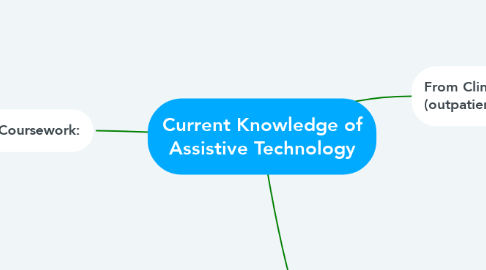
1. From Coursework:
1.1. Evaluation
1.1.1. MATCH
1.1.2. MPT
1.1.3. uPAR
1.1.4. QUEST
1.1.5. FEAT
1.1.6. PIDA
1.1.7. SETT framework
1.1.8. KWAZO
1.2. Types of AT I've learned about
1.2.1. Switches
1.2.1.1. BigMack swtich
1.2.2. iPad Applications
1.2.2.1. Read and Write for Google
1.2.2.2. Snap Type Pro
1.2.2.3. Zones of Regulation
1.2.3. Writing Aids
1.2.3.1. Pencil grips
1.2.3.2. Specially linted paper
1.2.3.3. Weighted pencils
1.2.3.4. Wicky sticks
1.2.3.5. Braille
1.2.4. High Tech
1.2.4.1. Word prediction software
1.2.4.2. Speech to text software
1.2.4.3. Tablets
1.2.4.4. AAC devices
1.2.4.5. Alternative keyboards
1.2.5. Cognitive tools
1.2.5.1. Color coding
1.2.5.2. Stickers
1.2.5.3. Simplifying visual field or language used
1.3. Universal Design/Design and Disability course
1.3.1. Learned about the ADA
1.3.2. Learned about section 508 of Rehab Act
1.3.3. Learned about IDEA
1.3.4. Analyzed the accessibility of different settings, including schools and public places (using ADA requirements and expanding beyond ADA)
2. From Clinical Experience (outpatient pediatric setting):
2.1. Medical AT
2.1.1. sock aids
2.1.2. dressing sticks
2.1.3. power wheelchairs
2.1.4. manual wheelchairs
2.1.5. AFOs
2.1.6. benik splints
2.1.7. head pod
2.1.8. curved utensils
2.2. Low AT
2.2.1. visual schedules
2.2.1.1. first, then boards
2.2.2. weighted vests
2.2.3. spring loaded scissors
2.2.4. slant boards
2.2.5. chewlery
2.2.6. noise-cancelling headphones
2.3. AAC Devices
2.3.1. iPad
2.3.1.1. LAMP application
2.3.2. eye gaze devices
3. Personal Experience:
3.1. use Apple products/have lots of experience using these devices and configuring different accessibility settings
3.1.1. MacBook
3.1.2. iPhone
3.1.3. iPad
3.1.4. Apple Watch

